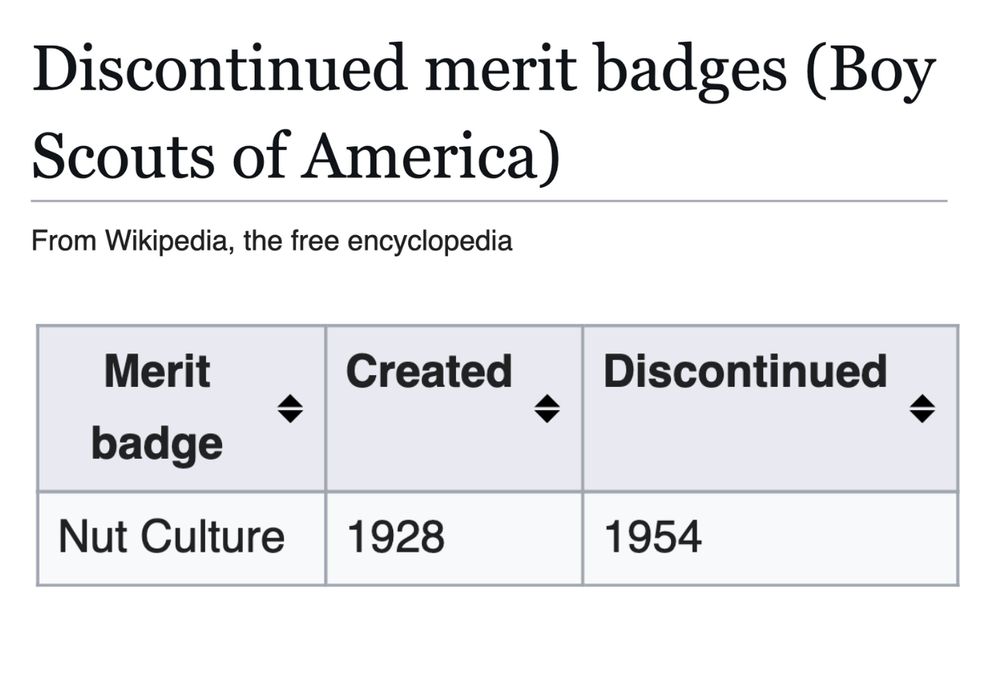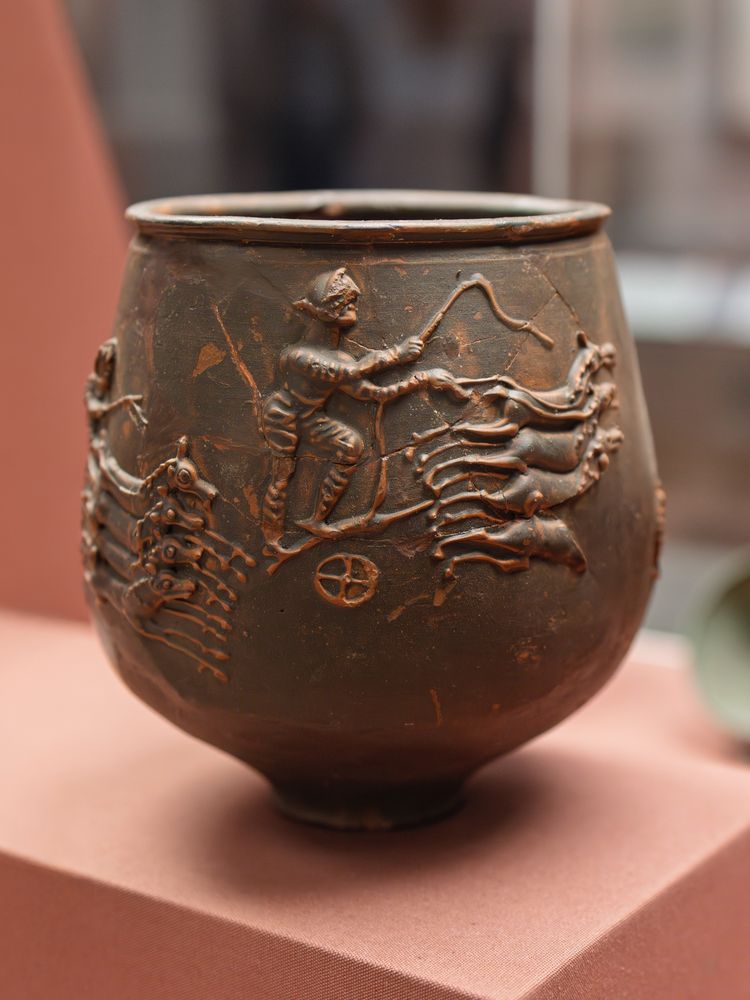
2,700-year-old temple with 'sacred cave' discovered in Turkey — and it may honor the 'mother goddess' | Live Science
www.livescience.com/archaeology/...
@spencermcdaniel.bsky.social
Studies ancient Greek cultural and social history, BA history and classical studies @IUBloomington, MA @BrandeisCLAS, she/her.

2,700-year-old temple with 'sacred cave' discovered in Turkey — and it may honor the 'mother goddess' | Live Science
www.livescience.com/archaeology/...

"discontinued merit badges (boy scouts of America)" wikipedia page shows "nut culture", 1928-1954

stalker merit badge 1910-1922, stalking merit badge 1911-1952

invention merit badge 1911-1917. only 10 scouts achieved it, required that they obtained a federal patent

List of discontinued merit badges (Boy Scouts of America)
03.10.2025 23:52 — 👍 1478 🔁 293 💬 34 📌 31Obviously, this is *not* behavior that anyone should admire or seek to emulate, but it is a reminder that the gospels do not always portray Jesus as the perfect, all-loving, compassionate figure that modern popular culture has made him out to be. He has a nasty side and is sometimes xenophobic.
2/


A lot of people forget that, in a real gospel passage (Mark 7:24–30 and Matthew 15:21–28), a woman begs Jesus to exorcise a demon from her daughter, and Jesus initially refuses and compares the woman to a dog because she is a Gentile. He only belatedly relents and agrees to exorcise the demon.
1/

Large cup or jar, dark brown (it would have been glossy black when new) depicting a chariot race in barbotine decoration, which unsurprisingly looks a lot like cake icing details, because it's piped onto the cup in the same way, with a bag. The auriga - charioteer - wears long-sleeved jerkin and leggings, and a leather helmet. He holds a whip in his right hand, and the reins of the four horses in his left. Another chariot is fast on his heels. Found at Colchester, Essex. British Museum (1857,0806.1)

Same description as the first image. The cup rests on a very small, stumpy foot which flares up into a broad vase shape, slightly tapering at the top. This is taken on the adjacent side to the left of the other chariot, and this chariot is the one at his heels.
A perfect souvenir from a day at the chariot races! This pottery cup or jar has barbotine (liquid clay) decoration, piped on just like cake icing. It depicts four quadrigae (four-horse chariots) in an endless circular race. 🏺 #ancientbluesky 1/
Colchester, 2nd c. CE. 📸 me
So the cool thing about this: there are two scripts here, Bactrian and Brahmi. The Brahmi is a common Buddhist curse formula, the Bactrian appears to be gibberish.
No clue if the curse is still active (we'll find out I guess), but the nail can still probably give you tetanus
And somehow this isn't even the most insane thing that Peter Thiel has ever said. . .
26.09.2025 15:38 — 👍 4 🔁 0 💬 1 📌 0Fun fact, a “cupa” is a barrel in Latin. People who made a cupa later became coopers. I like to tell this to everyone Cooper I meet whether they want to hear my etymology or not.
23.09.2025 11:25 — 👍 160 🔁 23 💬 3 📌 3Also, anyone who knows anything about the struggle between the Optimates and the Populares in the first century BCE knows that Julius Caesar's policy positions were closer to today's radical left than those of the avowedly aristocratic Optimate-sympathizing Senators who assassinated him.
17.09.2025 12:04 — 👍 0 🔁 0 💬 0 📌 0Oh my gosh, "Elendil" (a fictional character from Tolkien's legendarium) is also on here.
17.09.2025 11:37 — 👍 0 🔁 0 💬 1 📌 0The most hilarious part of this is that one of the people he claims was assassinated by "the radical left" is "Arthur P." short for Arthur Pendragon (a.k.a., King Arthur), who wasn't even a real person.
The photo is of Bradley James, who played Arthur in the 2000s BBC fantasy drama series 'Merlin'.
The destruction of the Gaza city mosque is a devastating loss to humanity as a whole. A part of our global medieval heritage destroyed in furtherance to a genocide. I despair.
17.09.2025 11:16 — 👍 1648 🔁 597 💬 14 📌 5
Two turquoise-blue hippopotamus figurines, one larger with black plant motifs and an open mouth, the smaller one lying on its side.
Two adorable Egyptian figurines: a roaring hippo and a baby hippo, dating ca 1,800 BC. Hippos were associated with life and rebirth. On display at Neues Museum Berlin. 📷 me
🏺 AncientEgyptBluesky


A scribe’s effort to correct an omission. The words that were accidentally left out are pulled along by one man who passes them to another who waits between the fourth and fifth lines to receive them - c. 1300, English Book of Hours, Walters Ms. W.102, f. 39v
14.09.2025 04:44 — 👍 109 🔁 30 💬 2 📌 1Merely being respectful of a human life does not entail writing op-eds for *The New York Times* or press releases praising Kirk's politics or his way of doing politics (both of which were deplorable).
12.09.2025 04:10 — 👍 0 🔁 0 💬 1 📌 0To be clear, I am not saying that anyone should celebrate or derive satisfaction from Charlie Kirk's death; he was a human being, and all humans deserve some respect. I am, however, critiquing the way that pundits and politicians (e.g., Ezra Klein for the NYT, Gavin Newsom, etc.) are valorizing him.
12.09.2025 04:03 — 👍 0 🔁 0 💬 1 📌 0
Screenshot of a tweet by Ezra Klein linking to his own op-ed in 'The New York Times' with the headline "Charlie Kirk Was Practicing Politics the Right Way"

Screenshot of a tweet by Governor Gavin Newsom of California praising Charlie Kirk and declaring, "The best way to honor Charlie's memory is to continue his work: engage with each other, across ideology, through spirited discourse."
The level of out-of-touch, craven, dishonest sycophancy among (supposedly) center-left pundits and politicians at this moment is simply unparalleled.
11.09.2025 16:10 — 👍 11 🔁 2 💬 0 📌 0I absolutely condemn political violence in all forms and instances.
Nonetheless, Charlie Kirk was an odious person who spent his life fomenting hatred, and it is shameful that media outlets and Democratic politicians are praising and eulogizing him just because he was murdered.
Actually, Frankenstein is an undergraduate at the University of Ingolstadt with an interest in alchemy who created a monster using an unclear scientific principle of his own discovery, suffered a nervous breakdown over the horror of his creation, and dropped out success at the Venice film festival
11.09.2025 03:01 — 👍 9 🔁 0 💬 2 📌 0"How Are the Very Rich Feeling About New York’s Next Mayor?"
A Dramatic Reading of The Recent New York Times Dispatch from the Hamptons.
Presented by The Gilded Age's Morgan Spector.
I'm only twenty-six and I have no idea what any of these terms mean.
Granted, I've never been on TikTok or Instagram or Tumblr or whatever the kids are using now and I'm very much not plugged into any kind of youth culture.
Fufluns - yes, *Fufluns* - was the Etruscan god of wine, happiness, growth, and health, equivalent to the god Dionysos. The male Etrusco-Latin votive bronze statuettes below wear ivy leaf wreaths on their heads and may represent the god’s priests. Or a Frisbee league. #BritishMuseum 🏺
29.08.2025 14:07 — 👍 187 🔁 36 💬 10 📌 3I think that a longer-reigning Julian, by reinforcing traditional institutions, would have postponed, and influenced the terms of, the post-Christian-dominance Roman religious settlement, but, by his reign, there was no question that a settlement of Christian dominance in some form was *coming*.
4/
It's very telling that Julian himself was raised as a Christian and his idiosyncratic, philosophically-minded, Neoplatonic version of traditional Greco-Roman religion was both a direct response to Christianity and, in its own way, Christian-influenced.
3/
We have to consider that Diocletian and Galerius tried to eradicate Christianity with the Great Persecution (lasted 303 – 311 CE) *before* the reign of Constantine and totally failed to do so. By Julian's accession in 361 CE, Christianity was thoroughly entrenched in all levels of Roman society.
2/
I kind of doubt this.
It is certainly true that, if Julian had lived and gone on to rule for decades, the world *would* look quite different today, but, by the time of Julian's reign, the Roman Empire was well past the turning point for a future in which Christianity would be a dominant force.
1/
There will be many casualties from UChicago ending ('pausing') PhD admissions in Humantities, but one which I am keenly aware of: this is close to a death sentence for teaching cuneiform in the United States (esp. Sumerian, Hittite, Elamite, Eblaite, Luwian) and it will affect the whole world.
27.08.2025 14:02 — 👍 1292 🔁 540 💬 21 📌 38I've started using DuckDuckGo, which I'm overall fairly happy with. They do have AI summaries, but it's very easy to turn them off, unlike with Google. Their image search feature also has a setting where you can filter out AI-generated images.
3/